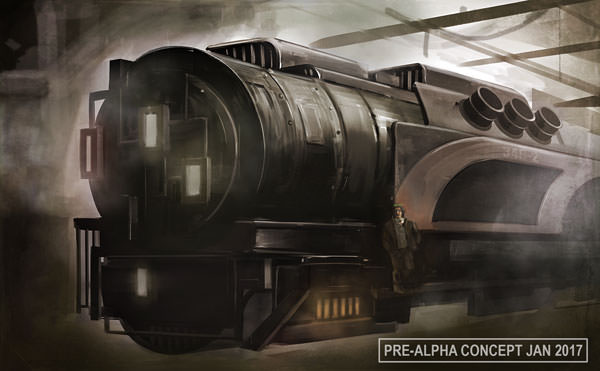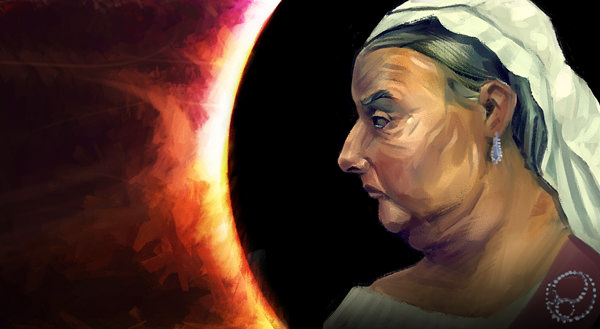Sunless Skies Pre-Production: Looking to the Skies
When we started making Sunless Sea back in 2014, art direction as a discipline was something I was only vaguely aware of. I had ideas about how I wanted the game to look - basically dark and vaguely teal-coloured - so I drew a lot of pictures and looked at a lot more, and the final result coalesced more or less by trial and error. (If you look at the original Kickstarter video, you can see it started out a great deal more cartoony than it is now.)
We’ve come a long way since then, and our self-imposed brief for Sunless Skies was to design a look for the game that is internally coherent, one that resonates with the time and setting of the game, the atmosphere we want to create, and the gameplay itself.
To do this we started with a list of requirements. The look of Sunless Skies had to:
- be recognisable but different
- evoke a late Victorian, fin-de-siecle period
- address corruption and compromise, one of the narrative’s key themes
- encourage exploration and a spirit of discovery
- be scary and dangerous
- suggest a new frontier, only partially explored
I'm going to dig into those ideas a little.
Recognisable but different: Sunless Skies is unabashedly a sequel, and as such it needs continuity. We toyed briefly with different camera positions, but quickly decided that we’re pretty good at the top-down perspective of Sunless Sea, and that we should build on that foundation rather than throwing it out. We’re doing that in many ways, but the most visually obvious is our use of parallax (a technique where background content moves at a different speed to foreground content, to suggest distance). Adding multiple layers of depth does a lot to convey the frightening, possibly infinite, nature of the High Wilderness and gives me a lot more space to build scenery without having to worry about the player running into it.
Victorian, fin-de-siecle period: Victorians in Space is an absurd idea, but once you get past the fact that it’s absurd, it’s compelling. All that expansionist spirit and industrial know-how on an unlimited canvas! Isambard Kingdom Brunel unshackled by gravity! What terrors might the Victorians construct? So as not to lose the richness provided by the Victorian era, I wanted the technology of the Enduring Empire to be plausible. It had to build on what was available at the end of the 19th century. This is why our spaceships are reminiscent of giant steam locomotives freed from their tracks, and we have signal boxes rather than, say, hyperspatial mass relays.
[caption id="attachment_4916" align="aligncenter" width="600"]
 Starship in drydock[/caption]
Starship in drydock[/caption]At the end of the 19th century, the art world of the period was going through an obsession with natural forms and decorative beauty for its own sake. This was the time of Alphonse Mucha, Charles Rennie Mackintosh and the Art Nouveau. The delicately organic stylings of that period are a wonderful contrast with all that heavy, steam-powered industry, and this struck me as a great visual metaphor for the can-do Victorians vs the fecund and deeply alien Wilderness. The border between the two - where rusted iron girders give way to flowering weeds and tentacles - seemed like a good place to pitch our tent. The imagery this conjures up effectively conveys corruption and compromise.
So, without going full-on Absinthe poster, we’re building some mechanical and organic shapes into our UI and anywhere else that feels appropriate. We might have Nouveau-style decals for player ships, for instance. We’re discussing a storyline where you ferry an artist of the period to spectacular locations in the hope that the vistas of the Wilderness will inspire them to paint.
We want to encourage exploration and discovery and preserve the atmosphere of unease and tension, ratcheting up as players spend time away from a safe haven. In Sunless Sea (and even more so in Zubmariner) we achieved a lot of this through darkness. The player’s field of view was limited by their glim light. You’d never know if that thing at the edge of the screen was a treasure, a safe harbour or the luminous eyes of a deadly zee-beast.
But we wanted the High Wilderness to be busy and stuffed with life - the antithesis of a traditional space game. And for the sake of easy navigation and to improve variety we wanted each region of the Wilderness to have its own distinctive colour palette, which is a bit tricky if it’s dark all the time. So instead of being filled with unrelenting darkness, the Wilderness is a place of winds, mist and fog. This is a versatile solution, because you can suggest giant shapes that may or may not repay closer inspection, and, as anyone who has played the Silent Hill games will attest, fog can be pretty damn terrifying. (As a big fan of The Mist, I’m looking forward to the fun we can have suggesting various ungodly things writhing in the distance.)
[caption id="attachment_4915" align="aligncenter" width="600"]
 An ungodly thing writhing in the distance[/caption]
An ungodly thing writhing in the distance[/caption]The final element in the list above is the sense of the frontier. This will be partly reflected in the construction of the game world itself. Parallax gives us access to multiple levels of construction, which is perfect for the bodged-together-with-gaffer-tape aesthetic we want for smaller colonies. However, I’m also working on a looser, more painterly style for the illustrations; combining the Art Nouveau influences mentioned above with more visible, impasto-ish brush work. The illustrations should give the impression that they might have been swiftly rendered in a naturalist's notebook. This portrait of Victoria was an early attempt to capture this style.

So we have a number of elements - locomotive technology, fog, organic and Art Nouveau shapes, parallax, and painterly roughness. Each addresses one or more points on our list of requirements. They should work together harmoniously, and not distract the player from the important business of exploring the outer reaches of space and scaring themselves silly. That’s the plan, anyway.
A note for readers: Sunless Skies is coming to Kickstarter on 1 February 2017. This was posted in January 2017, during pre-production. Any details in this blog are subject to change between now and the Kickstarter, in Early Access or after release.